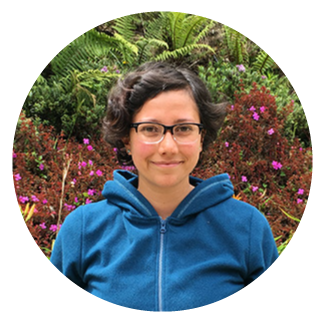Since 2015, GEO BON directly works with Colombia’s Alexander von Humboldt Institute to design a Colombian National BON. During 2015, and with the cooperation of GIZ (Germany), an assessment of the national capacities for Biodiversity Observation Systems in Colombia was undertaken. Following the Bon in a Box components (i.e. collection, management, analysis and reporting), an inventory of the tools produced and used by National Environmental Information System (SINA) institutions was consolidated.
In 2016, a core team from the SINA produced a Conceptual and Methodological Framework for Biodiversity Regional Assessments that was based on the 9 steps proposed by GEO BON to establish an Observation System (Fig. 9) and the Conceptual Framework for Regional Assessment of IPBES. The focus of this Framework is to link decision-makers’ information needs with biodiversity indicators and observation systems.
The work on the development of the Colombian BON has served as an example for other countries, namely Brazil and South Africa, in order to establish their National BONs. The overall process and approach for designing the national BON will be communicated as a CBD Technical Publication that will be used by GEO BON to serve as an applied provider of biodiversity observation expertise to the Parties of the CBD.
About Colombia BONCo-Lead
 Bibiana Gómez
Bibiana GómezInstituto Humboldt
 Helena Olaya
Helena OlayaInstituto Humboldt
Key objectives
- Build and maintain active a Community of Practice for developing Biodiversity Information Systems at National and Subnational scales.
- Guide biodiversity assessment process to support decision-making.
- Develop guidelines for enhancing biodiversity observation systems in data collection, management and analysis.
- Develop synthesis of existing information around specific research questions or policy/management problems.
1. Establishing a Colombian Landscape Ecology working group
| Leads | Camilo Correa and Paola Isaacs | |||
| Team/Partners | TBD | |||
| EBV Class | ||||
| Development approach | Capacity Building, Assessments and Policy Support | |||
| Description | Landscape Ecology in Colombia is a field of great interest for researchers and conservation practitioners, and can lead to results and outputs that are explicitly incorporated into decision-making instruments such as Land Planning policies. Building and maintaining an active Community of Practice for understanding ecosystem structure and process applying concepts and methods from Landscape Ecology is urgently needed, as well as identifying best practices in the field that allows government and consultants to develop more robust analysis on their territories. During the next three years, and as part of GEOBON, a specialist group on Landscape Ecology in Colombia will be organized addressing issues related with the implementation of an Observation System that aims to understand landscape transformations in Colombia. This activity will be organized around several tasks: 1. Define the objectives, membership and implementation plan of the working group 2. Review on the state of landscape ecology in Colombia: This review will lead to the production of a directory of experts, a publication on the historic and recent theoretical approaches to Landscape Ecology, a gap analysis on information and capacity in the country, the identification of opportunities and priorities of basic and applied research (e.g. connectivity, impact assessment, conservation planning, landscape social values). 3. Identify best practices for monitoring and data analysis in landscape ecology in support of policy making: Landscape ecology results are explicitly incorporated into decision-making instruments in Colombia. A review of information (mainly indices and indicators) demanded by decision makers will be performed, and publications and capacity building activities will be developed in order to share best practices in the field for monitoring and analysis. |
|||
| Timeline | 2017 | 2018 | 2019 | 2020 |
| Milestones and/or Deliverables | Meeting with experts in landscape ecology |
|
Meeting with experts in landscape ecology | |
| Resources | Secured: $6000 for the first workshop (Humboldt Institute) Needed: $5000 | Needed: $32000 | Needed: $12000 | |
| Link with other activities | This activity will be connected with the development of EBVs by the Ecosystem Function and Ecosystem Structure working groups. | |||
2. Developing the first subnational Biodiversity Assessments
| Leads | Maria Cecilia Londoño and José Manuel Ochoa | |||
| Team/Partners | TBD | |||
| EBV Class | ||||
| Development approach | Monitoring Protocol design, Modelling, Assessments and Policy Support | |||
| Description | The main objective of this activity is to develop a Biodiversity Observation Systems that improves data and information for national and subnational environmental authorities that are responsible for biodiversity management and ecosystem services. Members of the ColombiaBON have define a conceptual and methodological framework for integrating information needs from decision makers with biodiversity observation systems thorough the development of subnational biodiversity assessments. During the next three years, we aim to implement this assessment in at least two different regions of Colombia. Humboldt Institute will lead the implementation of this framework in the Orionoquia Region. This activity will be organized around several tasks: 1. Meetings of regional assessment group: Regional stakeholders will be invited to meetings where the approach for regional assessment will be explained and their roles identified. A first version of a causal diagram showing the most important biodiversity issues related to the region sustainability will be discussed. 2. Causal diagrams, indicators and variables identification: causal models will be developed and will be used to identify the set of biodiversity indicators and variables that are needed to be measured in each region. 3. Assessment of observation systems and development of dynamic models: An assessment of the actual observation system of each region will be performed based on the indicators and variables defined in the previous task. Recommendations for enhancement of the observation system will be delivered to the regional stakeholders. Synthesis and analysis of the available information will be done to report on the current state of biodiversity and its scenarios for sustainability. Opportunities for the implementation of actions for enhancing the observation system will be discussed with regional stakeholders. |
|||
| Timeline | 2017 | 2018 | 2019 | 2020 |
| Milestones and/or Deliverables | Meeting of the Orinocco regional assessment group |
|
Assessment for the second test case region | |
| Resources | Needed: $17000 for meetings with experts and regional stakeholders | Needed: $27000 for meetings with experts and regional stakeholders | Needed: $10000 for meetings with experts and regional stakeholders | |
| Link with other activities | This activity will be supported by the EBV Development TF and the Policy TF | |||
3. Developing the publication: Monitoring Functional Traits Handbook
| Leads | José Nicolas Urbina, Lilia Roa-Fuentes and Jairo Perez-Torres | |||
| Team/Partners | TBD | |||
| EBV Class | ||||
| Development approach | Monitoring Protocol Design, Data Collection | |||
| Description | The objective of this activity is to develop guidelines for enhancing biodiversity observation systems in data collection, management and analysis, by producing a series of handbooks that complement the existing monitoring protocols in Colombia. We aim to accomplish this activity by having a close cooperation with the different GEOBON EBV working groups and with other international specialist groups. In 2016, the first handbook for monitoring functional diversity (for plants, amphibians, fishes and birds) was publish but several taxonomic groups were missing. Due to the importance of understanding functional diversity for maintaining ecosystem process, the Colombian BON wants to produce the second volume for measuring functional traits in mammals, reptiles, fungus, algae, aquatic invertebrates, bacteria and ecological restoration. Other handbooks and capacity building activities to implement data collection, management and analysis will be identified in the following years. Their implementation will be subject to the availability of funds, personnel and other resources as well as to the working plans of the researchers and institutions involved. At the moment, nine potential chapters have been identified for this handbook. | |||
| Timeline | 2017 | 2018 | 2019 | 2020 |
| Milestones and/or Deliverables |
|
|
Publication of the handbook | |
| Resources | Needed: $13000 (for editor and graphic designer) | |||
| Link with other activities | This activity will be linked with activities of the Ecosystem Function WG and the Species Traits WG, pending on the establishment of the latter. | |||
4. Implementation of the Colombia Datacube for Biodiversity analysis
| Leads | Miguel Mahecha and Lina M. Estupiñan-Suarez | |||
| TBD | Over 53 partners from relevant universities, research institutes and protected areas | |||
| EBV Class | ||||
| Development approach | Modelling | |||
| Description | A first step to synthesize existing information, around specific research questions or policy/management, is to develop tools that facilitate the integration and analysis of large amount of data (in space and time). Our aim is to develop a first data cube for Biodiversity Dimensions which is a platform that supports the analysis and the development of indicators of the status and trends of biodiversity in Colombia. This activity is also connected with the Ecological Observatory System for Colombia, an initiative lead by the Max Planck Institute for Biogeochemistry and the Universidad Nacional de Colombia Medellin and discussed by several Academic Colombian Institutions during a workshop in November 2016. The first Data Cube development for Colombia will support biosphere/atmosphere variables (first version) and is based on the Earth System Data Cube from Max Planck Institute13. The development of the data cube will be done in 4 phases: Phase 1 – Production of the first version of biodiversity dimensions data cube: The first Biodiversity Dimension Data Cube (BD-DC) is developed at 1 km pixel size, and holds open access data derived from satellite devices or interpolation methods. Its main focus is to store and analysis efficiently time series to characterize biological large scale process. Additionally, it can be used to detect extreme events. The first version will support vegetation indexes (EVI, NDVI), leaf area index (LAI), Fraction of Absorbed Photosynthetically Active Radiation (fPAR), among others. Other variables integrated in the cube are clouds, precipitation and temperature. Phase 2 – Analysis of the Colombian biotic units: The Biotic Units of Colombia have been define based on beta diversity of species composition and incorporated in the Ecosystem National map. The assessment of BD-DC variables trend for each biotic unit will bring out a new perspective of biological process and function at larger scales. The outcomes will improve our understanding of biotic unit’s dynamics on species distribution. Phase 3 – Inclusion of new variables and previous ones updated: The data cube design allows to ingest the system with not only biosphere/atmosphere, and biodiversity variables but also social data. While human activities affect biodiversity in multiple dimensions, they are also vulnerable to the environmental variability. The inclusion of social, spatially explicit, data to the data cube will hence be crucial to study these relationships. Phase 4 – Change detection analysis: Land use change, natural disasters, among others, are phenomena that generate significant variations on the cube variables. Their detection may be used as inputs in a monitoring biodiversity system at landscape scales. Phase 5 – Update of the BD-DC: The data will have to be uploaded frequently in order to perform analysis within short time lags. |
|||
| Timeline | 2017 | 2018 | 2019 | 2020 |
| Milestones and/or Deliverables |
|
Inclusion and update of variables |
|
|
| Resources | Research grant from the DAAD (Germany) Needed: $7000 for workshops and meetings | Needed: $7000 for workshops and meetings | Needed: $7000 for workshops and meetings | |
| Link with other activities | Support from and/or collaboration with EBV Data Task Force | |||
Colombia BON is linked to the NASA projects:

